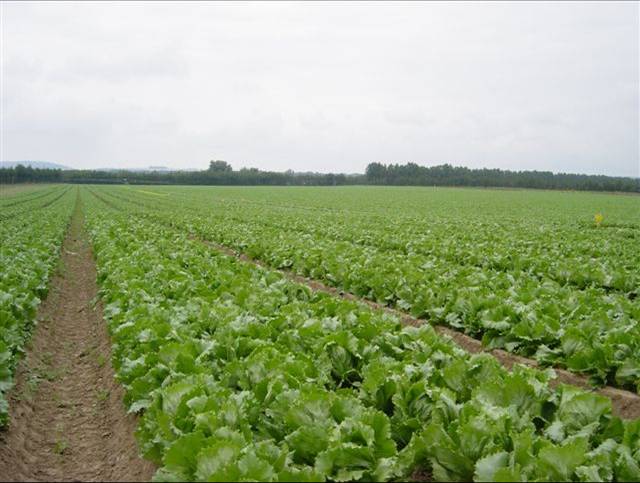
With the diminishing choice of chemistry and the need to employ a sustainable resistance strategy in vegetables and salad crops, specialist agronomist Dave Bolshaw of County Crops considers the new formulation of iprodione, Rovral WG, to be a helpful new addition to the armoury, particularly when it comes to Botrytis control.
"It is very important for growers of specialist crops to have a choice of fungicides, just like the arable growers do. So it was great that, when Rovral WG was re-registered this year, it retained the majority of its label recommendations including lettuce, Brussels sprouts and cauliflowers. I understand that PSD has also granted some new SOLAs* to replace those previously issued for Rovral Flo and Rovral WP including leafy salads and herbs. The SOLA system is essential for growers of minor crops and I am very supportive of it. It really helps vegetable growers who are increasingly struggling to find suitable and effective fungicides to use," says Dave.
Dave Bolshaw has been recommending Rovral in its many forms for a number of years now and considers it to be a very useful tool against Botrytis. "I have found the new WDG formulation very easy to use and more accurate to measure out."
He explains that Botrytis is a very damaging disease, causing problems of yield, quality and appearance. "The disease enters the plant via broken or damaged tissue caused by machinery or adverse weather and then it spreads further in wet and humid weather. It is essential to keep it out of the crop through a planned programme using fungicides with different modes of action."
"In lettuce for example we aim to use as few fungicides as possible but as many as necessary in order to produce high quality produce, within the confines of the label and protocols. Rovral WG has played a useful part in this crop by controlling Botrytis so well."
"In Brussels sprouts an effective disease control programme integrates a number of different fungicides with systemic and also contact activity, starting in September right through to November. Rovral WG can be mixed with other fungicides such as metalaxyl-M + mancozeb to add Botrytis control. This mix can be alternated with other fungicides with a different mode of action such as Signum. Signum is a very good product with a wide disease spectrum, including white blister and ringspot. It has good activity on Botrytis too, so wouldn"e;t warrant a specific mix with Rovral WG," says Mr. Bolshaw.
Simon Townsend, Agronomy Manager for BASF, reminds growers that the new formulation of Rovral WG has label recommendations for use in Brussels sprouts, cauliflowers, bulb onions, salad onions, protected tomatoes, protected lettuce, outdoor lettuce, outdoor and protected strawberries, outdoor raspberries, brassica seed crops, outdoor ornamental pot plants, protected pot plants, winter oilseed rape and spring oilseed rape.
"Rovral WG is a particularly effective fungicide with strong protectant and some eradicant activity. As a concentrated WDG, it is much easier to measure out and to use and has much less bulk and packaging to deal with. It is an important fungicide for many fruit, salad, ornamental and vegetable growers whose armoury of products is waning, whilst pressures on disease resistance is increasing. BASF are keen to support the UK agricultural industry by continuing to invest in new uses and approvals for these smaller but important cropping sectors," says Simon.
Rovral WG contains 750 g/kg iprodione, formulated as a water dispersible granule and packed in a 1kg pack. It is recommended in a wide range of crops including Brussels sprouts, cauliflower, onions, lettuce, oilseed rape, strawberry and raspberries. Rovral WG is a broad-spectrum fungicide with protectant and some curative activities. Its maximum individual dose is 0.67 kg/ha in oilseed rape, Brussels sprouts, cauliflower, bulb onions, salad onions and brassica seed crops and 1 kg/ha in strawberries and raspberries. Where it is recommended in high water volumes, its maximum individual dose is 67 g per 100 litres of water in protected tomatoes and ornamental pot plants and 33 g per 100 litres of water for lettuce. Maximum number of treatments vary from 1 to 5 depending on the crop and Harvest Intervals from 2 to 21 days depending on the crop.
*Growers intending to use a SOLA (also referred to as a Notice of extension of approved use) are required to know that prior to application they require a copy of the SOLA notification document, which they should keep with their records. Individual SOLA notification documents can be viewed and downloaded at www.pesticides.gov.uk/psd_databases/solaweb/solaweb_search.asp. SOLAs are used at growers own risk and the SOLA Notice of extension must be referred to for full conditions of use and specific restrictions. The new SOLA"e;s for Rovral WG are for use in protected and outdoor crops of cress, endive, fennel as a leafy herb, frisé, lambs lettuce, leafy brassica crops grown for baby leaf production, radicchio, scarole, protected herbs, outdoor herbs, chicory, outdoor garlic, outdoor shallot, protected rhubarb, protected aubergine, red beet (pre-storage), dwarf French beans, French beans, mange tout peas and runner beans, grapevines, and pears post-harvest.
For further comment and information please contact;
1) Dave Bolshaw, County Crops on 07710 601060 (mobile)
2) Simon Townsend, BASF on 01845 537072 or 07836 738161 (mobile)
